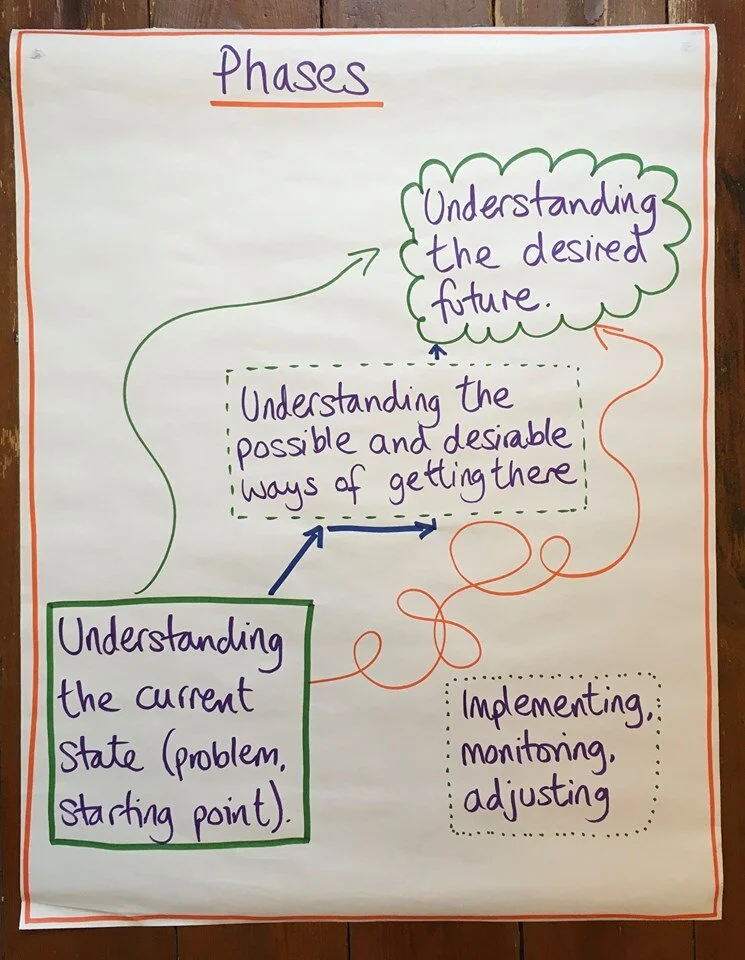Working with clients who are getting ready to consult stakeholders on options, I needed to help them see how the co-design journey could work from start to finish. This simple diagram helped a lot.
Powerful tools for stakeholder engagement
Decisions? Decisions!
This blog post pulls together some resources that I shared at a workshop last week, for people in community organisations wanting to make clear decisions that stick. Groups of volunteers can't be 'managed' in the same that a team in an organisation is managed: consensus and willingness to agree in order to move forward are more precious. Sometimes, however, that means that decisions aren't clear or don't 'stick' - people come away with different understandings of the decision, or don't think a 'real' decision has been made (just a recommendation, or a nice conversation without a conclusion). And so it's hard to move things forward.
I flagged up a number of resources that I think groups like this will find useful:
- Descriptive agendas - that give people a much clearer idea of what to expect from a meeting;
- Using decision / action grids to record the outputs from a meeting unambiguously;
- Be clear about the decision-making method (e.g. will it be by consensus, by some voting and majority margin, or one person making the decision following consultation?) and criteria.
- Understanding who needs to be involved in the run-up to a decision.
- Taking time to explore options and their pros and cons before asking people to plump for a 'position'.
Who shall we engage, and how intensely?
So you've brainstormed a long (long!) list of all the kinds of people and organisations who have a stake in the policy, project, organisation or issue that you are focusing on. This is what we call stakeholder identification.
What do you do next?
Stakeholder analysis
Now there are lots of ways you can analyse your universe of stakeholders, but my absolute favourite, for its conceptual neatness and the way it lends itself to being done by a group, is the impact / influence matrix.
Notice the subtle but important difference between this matrix, and the one most commonly used by PR and communications specialists, which focuses on whether stakeholders are in favour of - or opposed to - your plans. It would be inappropriate to use this for stakeholder engagement which engages in order to inform decisions, because you will be engaging before you have made up your mind. And if you haven't decided yet, how can stakeholders have decided whether they agree with you?!
Instead, the matrix helps you to see who needs to be engaged most intensely because they can have a big impact on the success or otherwise of the work, or because the work will have a big impact on them. It is 'blind' to whether you think the stakeholders are broadly your mates or the forces of darkness.
Map as a team
Your list is written out on sticky notes - one per note - and the stakeholders have been made as specific as possible: Which team at the local authority? Which residents? Which NGO? Which suppliers in the supply chain?
You have posted up some flip chart paper with the matrix drawn on.
The mapping is ideally done as a team - and that team might even include some stakeholders! During the mapping, everyone needs to be alert to the risk of placing a particular stakeholder in the 'wrong' place, because you don't want to engage with them. It's self-defeating, because sooner or later you will need to engage with the most influential stakeholders whether you want to or not. And sooner is definitely better than later.
You move the notes around until you're all satisfied that you have a good enough map.
Intensity? Transmit, receive, collaborate
When the mapping is complete, then you can discuss the implications: those in the low/low quadrant probably just need to be informed about what's happening (transmit). Those in the diagonal band encompassing both the high / low quadrants need to be asked what they know, what they think and what they feel about how things are now, how they might be in the future and they ways of getting from here to there (receive). NB those in the bottom right corner - highly impacted on but not influential. Vulnerable and powerless. Pay particular attention to their views, make a big effort to hear them, and help them gain in influence if you can.
Those in the 'high/high' corner are the ones you need to work most closely with (collaborate), sharing the job of making sense of how things are now, co-creating options for the future, collaborating to make it happen. Because if they are not on board, you won't be able to design and implement the work.
Prioritise and plan
Now you are in a position to plan your engagement, knowing which stakeholders need mostly to be told, mostly to be listened to or mostly to be collaborated with.
Review and revise
Watch out for people and organisations moving over time. Very often the people in bottom right are the unorganised 'public'. They might be residents or consumers. If they get organised, or their cause is taken up by the media, a celebrity or a campaign group then their influence is likely to increase.
Those in the top left are potentially influential but unlikely to get involved because there's not so much in it for them. Your engagement plan might include helping them to see why their input is useful, and piquing their interest.
So stay alert to changes and alter your engagement plan accordingly.

